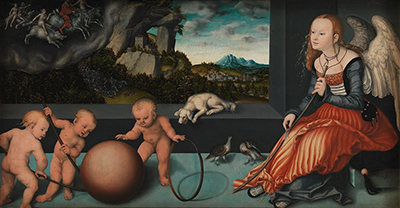Melancholia is an oil on wood painting created by Lucas Cranach the Elder in 1532. Lucas Cranach was a well-known German Renaissance painter and printmaker of the sixteenth century. He created this highly detailed piece of work in response to Durer's engraving of Melancholy.
This piece is among a series of paintings created between 1528 and 1533 by the artist. The painting is currently located in the National Gallery of Denmark. In the background, we see a beautiful landscape yet so highly mysterious. Everything seems so surreal. To the left of the two cities are dark clouds filled with horses and witches riding different types of animals. There's a whole army on the move with no visible enemy in sight. On the balcony overlooking the chaos is a female figure with wings in an orange dress. She seems lost in thought even amid all the frenzy. In this painting, there are three naked toddlers on the balcony too. They are trying to pass a large ball through a hoop. The winged woman is carving a long stick using a knife maybe to create another hoop. Her expression is boring as she stares in space ignoring the playful toddlers. On the balcony, is a puppy sleeping and just below it are two birds.
Cranach the Elder continued to produce at least three versions of the Melancholia. In two of them, the female figures wore red dresses and had angel wings, one with black wings and the other with white wings. Interestingly, the last three have strange apocalyptic visions in the upper left corner, with a distant view, and each woman carves as the children play. In another version, there are four children tormenting a dog that was sleeping. The other elements depicted are a table, bench, and a blackened fruit.
The moral philosophies of the Renaissance served as the basis for understanding the world and how to we should go about our living our lives. One possible evaluation of this painting is that the Melancholia reflects the opinion of Martin Luther, a friend of Cranach. He believed that this depressing temperament is a "bath of Satan" and must be countered by "spiritual joy" and faith in the Word of God. Luther believed that melancholy could lower your determination. Cranach in the painting depicts a woman filled with melancholy; she feels she has achieved a little and is fated to grow old while only bringing up her children. Instead, to shun all these we must seek happiness and comfort in spiritual matters.




